Six North Faces of the Alps: Piz Badile
The North East Face of Piz Badile
The Cassin route
Time taken: 1 long day and bivouac at base
Climbing partner: Phil Dowthwaite
Photos: With thanks to Jim Evans, Steve Woollard and IFMGA Mountain Guides Graham Frost & Tim Neill
The North East Face of Piz Badile was the first of all the classic six North Faces of the Alps that I climbed and it was so important and inspiring for me. Climbing this route made things feel possible and gave me the fire and confidence for bigger challenges. It is where my big Alpine North Face climbing ambitions started.
I was climbing with Phil Dowthwaite and we were on our second Alpine climbing trip together, having together climbed the North Ridge of the Piz Badile the previous year with another friend, Jim Evans. Phil and Jim were key climbing partners of mine at the time and I learned a lot from both of them. Both Phil and Jim really showed me the way with many aspects of summer and winter climbing, including a few Alpine climbing trips to Chamonix and Switzerland. At the time Phil was training to be a Mountain Guide and had been climbing hard from a very early age. His stories and achievements always inspired me and I enjoyed all our climbing adventures together and respected his experience.
We would save up a little and every Summer book some time off work and do the huge road trip out to the Alps. I remember driving in shifts through the night. It was always exciting and traveling to brand-new places always feels like a proper adventure. I was lucky, in my circle of friends it just seemed like the thing you always did. Rain or shine, the regular summer trip to the Alps would happen without doubt.
Every summer the size and quality of tent would improve, until one summer it seemed like a competition was on to see who brought the biggest tent and then massive tents became standard. I think one year our tent was so big you could back the car into it. Phil always had the best car too, so it was amazing that every summer he would allow us to use it and sometimes even do a driving shift too.
I knew very little about the 6 Classic North Faces of the Alps so having the chance to climb even one of the North Faces at the time felt like a big thing. It was mid-summer 1998 and we were camping in Chamonix, I was keen and learning lots, trying for big routes in the mountains and sometimes failing and often having to down scale ambitions and expectations. It was part of the process and I slowly learnt that going away having climbed maybe 1 or 2 of your big list was a success and that struggling with the altitude become the norm. I was young and knew relatively little about alpine mountaineering, however it was already a big part of my life and I was committed to learn more.
Our climbing was feeling good at the time and with the Piz Badile on our radar we checked out the weather forecast for that area. The Piz Badile mountain is in the South Eastern corner of Switzerland in the Bregaglia mountain range and in the Canton of Graubunden. The Mountain sits on the border with Italy, and the North Face is accessed via Switzerland from a village called Bondo. The area is famous for its big granite mountains and feels quieter than other busy and popular Alpine mountain destinations.
We needed a change of scene and after climbing with friends Paul Platt and Phil Baker, we decided to team up and drive over to the Piz Badile for a big North Face adventure.
.
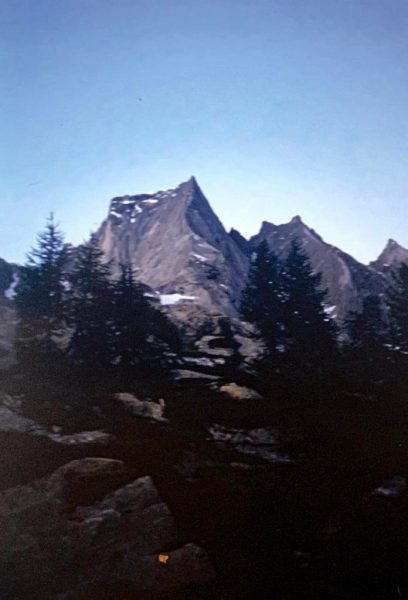
North Ridge facing, with North East Ridge to the left, 1997. Photo Jim Evans
.
The North East Face of Piz Badile was first climbed by Ricardo Cassin and team in 1937. Unknown to R. Cassin, V. Ratti and G. Esposito there was another team already attempting the route at the time – Mario Molteni and Giuseppe Valsecchi. They ended up joining forces and climbed the wall over 3 days. Unfortunately Molteni died on the summit and Valsecchi died on the descent just before reaching the hut. An awful and sad story about the first ascent of such a great North face climb and so important in Alpine climbing history. You can’t help but think what the mountains would have been like in 1937, and how it would have been to climb such hard routes back then.
The road trip over and through Switzerland acted as a good break. The change of scene was really refreshing and exciting, just what we all needed and we all enjoyed the odd coffee break in the sun too. Doing driving shifts we were soon off the motorways and back on the quiet small roads heading into the Bregaglia mountain region. We knew we were still in Switzerland, but it did start to have an Italian feel about it, with the border close and in parts a different language is spoken here called Romanche.
Arriving in Bondo we used the same campsite as the previous year for when we climbed the North Ridge of Piz Badile. I remember walking around and how quiet the village was, we struggled to even find a weather forecast. We had to be quite creative when it came to food shopping because there was no supermarket, only a tiny shop that we could just barely all fit into. It was tricky to find everything we needed but Phil being an amazing chef cooked a superb evening meal and we seemed to always find enough red wine.
That evening we sorted and packed the climbing gear for the climb, we also talked over logistics and agreed to bivouac at the base of the climb the next day. It was going to be a long walk from the road head to the base of Piz Badile and we worked out that at best the climb and descent was going to take one long day, so we packed for 2 days away and one bivouac. We were all excited and after dinner and packing we relaxed and chatted about how special it felt being somewhere different and in such a cool mountain region.
The campsite agreed it was ok to leave the tents up and, in the morning we loaded the car and drove up the road for as far as we could. Parking up at the road head in the forest, the sun was shining and it was then that we could start to see the mountains just above the trees. I had seen pictures of Patagonia and British Columbia and it looked just like that, with huge granite towers above and in the valley a tree line with rolling terrain. We all picked up our heavy rucksacks and slowly started walking up through the trees and out into open rolling terrain, mostly on footpaths heading straight for the Piz Badile. We passed a mountain hut on the way, where we stopped for a little break and a chat with the Hut Guardian. I didn’t feel that confident, so Phil did all the talking and the Guardian indicated that the mountain was in great condition and as we left he smiled, waved and wished us luck.
Walking above and away from the hut we could slowly start to see more of the mountain, and we were able to look straight at the North Ridge we had climbed the previous summer. One of our concerns was how much snow there was going to be on the mountain, and from what we could see things were looking good with very little snow anywhere other than a small snow patch at the base of the mountain. Higher up we were now walking on a vague track through boulders and all of us were hoping to bivouac soon, managing fatigue levels for the next day’s climb. We had heard of a good bivouac at the base of the North Ridge climb so we aimed for that. We were planning to leave our bivouac gear there and pick it all up on the descent.
It was now late in the day and we easily found a good well used bivouac, a comfortable and spacious piece of ground with its own little wall for shelter that other climbers had built with surrounding stones. It was close to the North Ridge and the access point to the North Face, so after making a cup of tea we walked up to take a closer look at the access point for the next day’s climb. I remember standing at the base of the North Ridge looking across the huge North Face and all of us were happy to see no snow on the route and access point. The North Face looked massive and we all tried to visualise how it was going to feel in the dark for our early start in the morning, cross checking the topo and guidebook description and trying to make the most of this relaxed reconnaissance. All of us could see the route and we stood there pointing out features and observations, listening to each other and double checking the logistics. Teamwork is so important and is the best aspect of big adventures. Together we all contribute to the climb. It was slowly getting dark, so we all agreed we had seen enough so walked back to the bivouac and got everything ready before getting in the sleeping bags. My legs were pretty tired and as always wished I’d done some more training, so getting into the sleeping bag and lying down was nice, even though it was on a gravel floor outside. With everything zipped up I started to feel the cold Alpine air on my face, so I rolled over, closed my eyes and tried to sleep and waited for the Alpine start.
The alarm went off, it was still dark and I could see stars and clear skies above us. Sitting up I could also see the dark shape of the Piz Badile, which at night looked even bigger and intimidating. It’s difficult to get a good sleep during a bivouac so I was feeling tired but continued to pack away the sleeping bag and have a little food. There’s no real time for hanging around prior to a big route like that, so we were all busy getting sorted and having a little breakfast at the same time. We packed away and made a gear stash of the bivouac equipment, aiming to pick it up on the way down, and started the short walk to the access point with all our climbing gear on ready.
The route is around 800m long and at around 25 pitches it has a rock-climbing grade of UK HVS/E1 and Alpine TD, so an early start was essential. We were hoping to be on the summit in good time and we were feeling confident about the descent as we had climbed and abseiled this the previous year. It was still going to be a big day, and what we carried with us had to be lightweight in order to maintain pace and energy for all the climbing and descent. In our rucksacks was around 1.5 litre of water each, some food (mainly bars, meats and cheese) a duvet jacket, a waterproof jacket, hats and gloves and bivouac shelter just in case. This may not sound a lot but surprisingly it all adds up, especially when you have to rock climb with the rucksack on. We had a pair of lightweight mountain boots too, and these were in the rucksack or sometimes clipped to our harnesses.
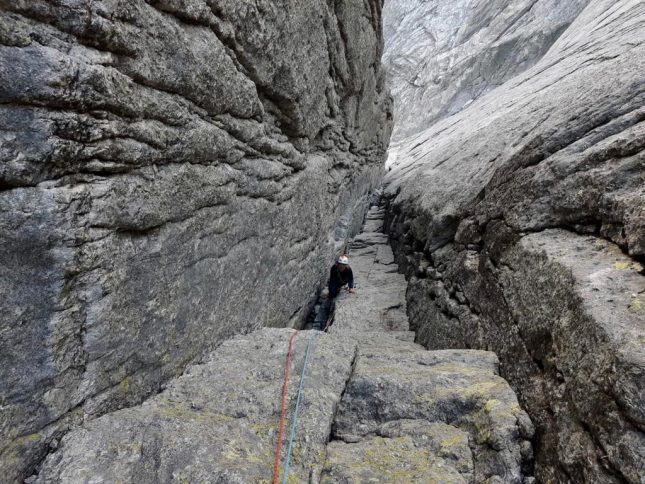
Climbing Cassin North East Face, Photo by Graham Frost
We were doing well for time and soon we were scrambling off the North Ridge down and on to the North East face route. We then had to traverse a section, normally built up with snow, however this time round there was only a big rock slab to climb across. The climbing was ok, but in the dark it felt serious and exposed with a glacier far below us. Roped up climbing and with all the rope out we were moving together with runners in the rock for protection. This technique allowed us to keep pace on the easier but serious terrain. Soon after this traverse everything slowed down as the climbing started to get harder. Now having to pitch we agreed to block lead as much as possible, meaning one person would lead climb maybe 5 or 6 pitches at a time and swap over. This is a technique mentioned during the other North Face climbs articles and works well at saving time on stance change overs and can help maintain focus for the lead climber and provide a decent rest for the second too. Just like on other big routes, we had a lighter rucksack in the team, which would be given to the lead climber to help reduce the effort and would be swapped around. The second not having to lead climb at the time would then have a heavier bag, a trade off for having less risk seconding the pitch, but this shouldn’t be underestimated as it can be quite tiring.
It was starting to get light and ensuring we were on route we would always pause to check the route description at belays. Paul and Phil were climbing ahead of us at this point which helped loads and meant we didn’t have to think about the route finding as much. Our turn would come to take the lead and route find as we would meet up at belays.
It was getting light and we had already climbed the initial hard pitches of the route including the Rebuffat Deidre and pausing at a belay we switched our head torches off and put them away in our rucksacks.
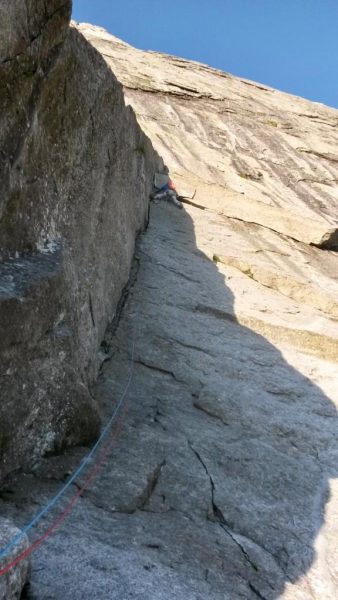
Graham Frost climbing Rebuffat Diedre. Photo Steve Woollard
We were making good time and the route finding was going well, and now with Phil and myself in front there was more importance on getting the route finding right. All the time looking for signs of previous climbs, clues like old pitons or stuck gear from other climbers, helped keep us on route. Climbing as two teams felt quite comforting on such a big face, especially as I was new to all this big climbing, their support really helped relax the tension.
On the easier sections we sometimes moved together, however most of the time we would pitch climb and getting into a routine helped with this. We were soon halfway and the rest of the route could be clearly seen, with the exit chimneys in sight. Id heard horror stories of these filled with ice and was so hoping this was not going to be the case.
I remember mid-way some hard climbing and just around the time when you’re starting to get tired too, mentally and physically. You start to really feel the rucksack when you’re on harder sections of climbing and start to draw upon all your efforts to get up the pitch in good time. The corners and cracks had many pitons from old aid ascents, and it was easy to sometimes use these to help with your climbing, I guess my main worry was time and did not want to hold us up in anyway. I remember climbing a corner/crack at my total limit and seeing Paul and Phil at the belay above, I was quite envious as they seemed to be doing just fine but there I was, fighting away just trying to keep pace.
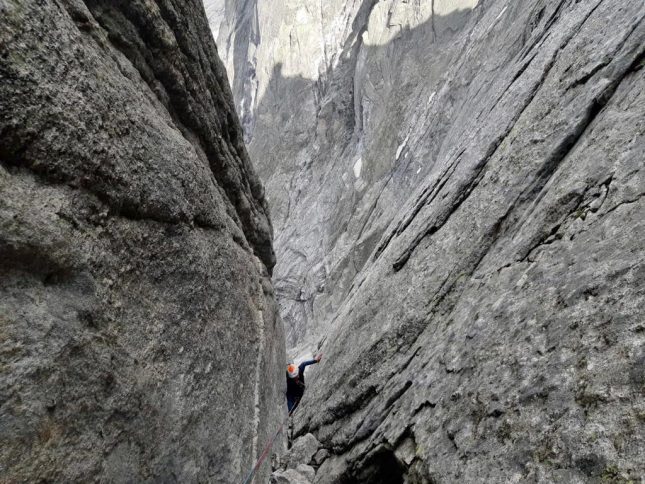
Climbing the exit cracks. Photo by Graham Frost
At the belay I was reassured to hear that they too found that section difficult and looking up we could see the start of the exit chimneys; I needed a break and Phil took over leading. We were now in front and I tried my best to recover and reserve some energy whilst seconding Phil, even with the summit ridge in sight.
.
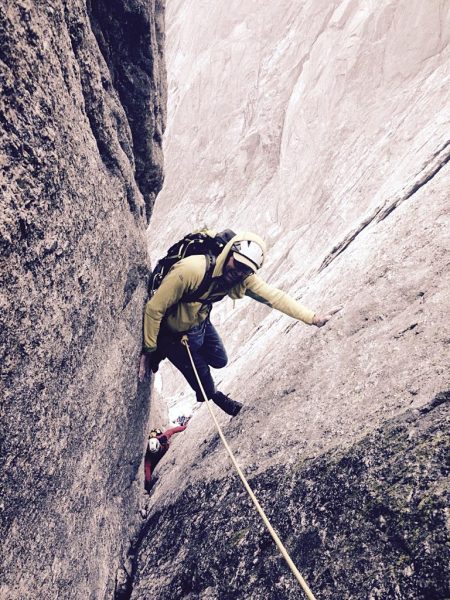
Nick Bullock climbing exit cracks. Photo Tim Neill
.
Phil always did an amazing job lead climbing and kept us on route, even though some of the chimney pitches were desperate. They are always hard to climb and you were torn between the choice of getting your body full in the crack and using full body contact back and foot tactics or delicately bridging in space with your feet on the smooth steep side walls – both techniques felt quite horrendous and still today chimney climbing is not my favourite.
Now near the top of the North Face with only a couple of pitches to go, we could clearly see the summit ridge.
With sore feet from climbing all day we arrived on the summit ridge, all of us happy with our achievement and surrounded with stunning mountain views. My hands and feet aching. This was my first big classic North Face and I had mixture of feelings. I was happy but mentally exhausted and knowing we still had the descent to go I retained most of my total celebration.
Having Phil and the others there helped so much with this and now faced with possible afternoon storms and a long abseil descent, I still felt safe and confident in the strong team I was with.
We knew the North Ridge so chose that as our descent, which was going to include many abseils and some down climbing. We descended as a team, sticking together and chatting as we waited at abseil stances. All of us tired yet still focused on our task and long day, we had shared our thoughts as sometimes we struggled to squeeze onto the same belay. The descent was safe but very long and our memory of the route seemed to be good and we made good progress making around 19 abseils including some down climbing.
.
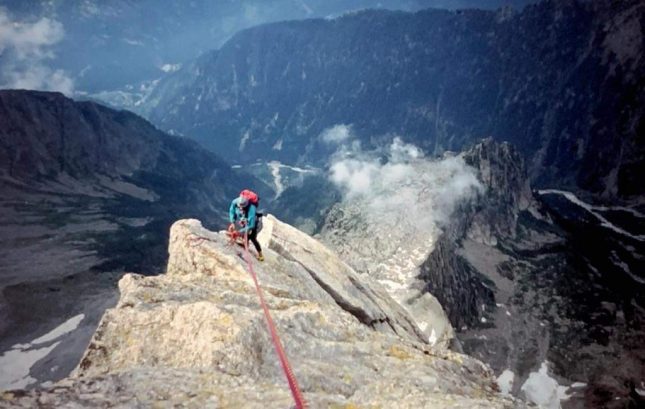
Descending the North Ridge in 1997. Photo Jim Evans
.
Down to our last food and water we reached the base of the North Ridge late that afternoon/early evening. We had a little rest at our bivouac site and picked up the rest of our gear and had what food was left there.
Deciding not to bivouac another night we chose to pack up and carry on walking down to the valley through the night. Now with comfortable boots back on it felt like heaven for my toes and to be off the mountain safe and successful was a big relief. We were all proud of our efforts and what we had achieved, but knowing we had a long walk still to go, all we wanted was to be back in the valley and having a sleep.
Soon headtorches were on and it was starting to feel like we had been up all day. The weather had held and it was another clear night. We were all buzzing from the amazing climb and our big day out, all of which helped with the long walk back down into the valley.
We arrived back at the car at around 1am, I remember my legs were aching and being so happy the day was done. We drove down the tiny forest road, pulling into the campsite. We all congratulated each other, and I crawled into my tent to lie down.
Sleeping after such a vivid experience can sometimes be difficult, thinking about the challenges and processing everything, but I was happy, exhausted, and content.
We had all had our big mountain fix and the weather was due to change, so we started making plans. We decided to drive to the south of France and go sport climbing on our way back to the UK.
We packed the car slowly and got the road map out. We managed to navigate and survive driving through a busy Milan and that evening found a campsite in the quiet French village of Orpierre. Orpierre is a world class sport climbing venue and a beautiful small village in the South of France. We relaxed in the sun and went sport climbing most days, and in the evenings make nice food and often chatted about our climbing in the mountains and the North Face of the Piz Badile. It was the perfect end to our trip.
Now some 20 years later and having climbed the 6 classic North Faces of the Alps, I feel so lucky to have had these experiences. Back then like on the Piz Badile it was all brand new to me. I tried to keep up but I was very young and had so much to learn. Thank you to all the total heros I’ve climbed these routes with and always learnt so much from, as climbing partners and good friends.
.
Don’t miss the rest of the series:
Six North Faces: Aiguille du Dru
Six North Faces: Grandes Jorasses
.
About Stuart McAleese
.
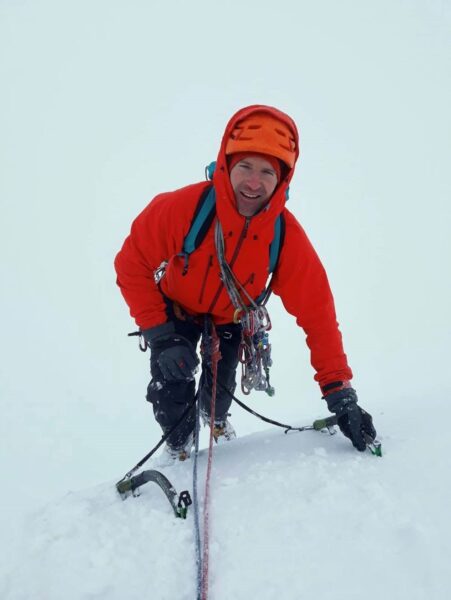
.
Originally from Northern Cumbria I started out hill walking in the Lake District when I was at school. I soon become interested in rock climbing and mountaineering, and was lucky enough to work and climb with Mountain Guides during my first job leaving school. Since then I’ve been working full time in the mountains for around 20 years.
At the same time as working, I enjoy climbing in my free time and have been lucky enough to go on many expeditions around the world, climbing new mountains, first ascents and tough remote summits. Places such as Patagonia, Alaska, Himalaya, Peru, Baffin Island, Yosemite and China. In 2004 I was nominated for the prestigious Piolet d’Or in Grenoble, France, for a 1st ascent of the ‘Supa Dupa Couloir’ in Alaska.
I love my job as a Mountain Guide, teaching and exploring big mountains in all weather all year round. I joined the Glenmore Lodge team in 2019 and head up the Summer Alpine programme as well as delivering on the Rock & Mountain programme of training courses.